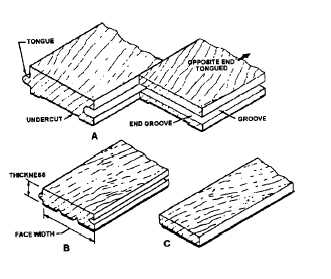CHAPTER 6
INTERIOR FINISH OF FLOORS, STAIRS,
DOORS, AND TRIM
This chapter continues our discussion of interior
finishing. In the previous chapter, we looked at the
interior finishing of walls and ceilings, and related
aspects of insulation and ventilation. Now, we’ll
examine the common types of flooring and the
construction procedures for a stairway and interior
doorframing. We’ll also discuss the types of wood trim
and the associated installation procedures.
FLOOR COVERINGS
LEARNING OBJECTIVE: Upon completing
this section, you should be able to identify the
common types of floor coverings and describe
procedures for their placement.
Numerous flooring materials now available may be
used over a variety of floor systems. Each has a property
that adapts it to a particular usage. Of the practical
properties, perhaps durability and ease of maintenance
are the most important. However, initial cost, comfort,
and appearance must also be considered. Specific
service requirements may call for special properties,
such as resistance to hard wear in warehouses and on
loading platforms, or comfort to users in offices and
shops.
There is a wide selection of wood materials used for
flooring. Hardwoods and softwoods are available as
strip flooring in a variety of widths and thicknesses, and
as random-width planks and block flooring. Other
materials include linoleum, asphalt, rubber, cork vinyl,
and tile and sheet forms. Tile flooring is also available
in a particleboard, which is manufactured with small
wood particles combined with resin and formed under
high pressure. In many areas, ceramic tile and carpeting
are used in ways not thought practical a few years ago.
Plastic floor coverings used over concrete or a stable
wood subfloor are another variation in the types of
finishes available.
WOOD-STRIP FLOORING
in bedroom and closet areas where traffic is light.
However, it is less dense than the hardwoods, less wear-
resistant, and shows surface abrasions more readily.
Softwoods most commonly used for flooring are
southern pine, Douglas fir, redwood, and western
hemlock.
Softwood flooring has tongue-and-groove edges
and may be hollow-backed or grooved. Some types are
also end-matched. Vertical-grain flooring generally has
better wearing qualities than flat-grain flooring under
hard usage.
Hardwoods most commonly used for flooring are
red and white oak, beech, birch, maple, and pecan, any
of which can be prefinished or unfinished.
Hardwood strip flooring is available in widths
ranging from 1 1/2 to 3 1/4 inches. Standard thicknesses
include 3/8, 1/2, and 3/4 inch. A useful feature of
hardwood strip flooring is the undercut. There is a wide
groove on the bottom of each piece that enables it to lay
flat and stable, even when the subfloor surface is slightly
uneven.
These strips are laid lengthwise in a room and
normally at right angles to the floor joists. A subfloor of
diagonal boards or plywood is normally used under the
finish floor. The strips are tongue and groove and
end-matched (fig. 6-1, view A). Strips are random length
Softwood finish flooring costs less than most
hardwood species and is often used to good advantage
Figure 6-1.—Types of strip flooring.
6-1

